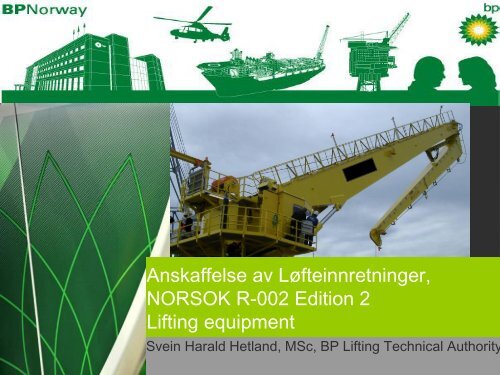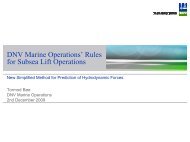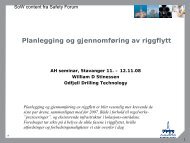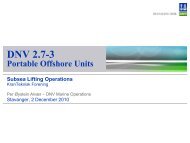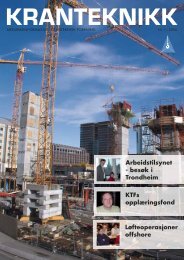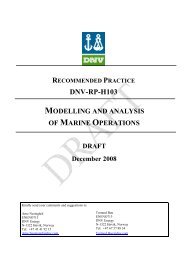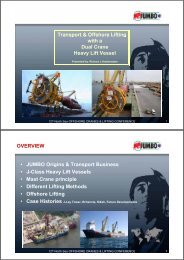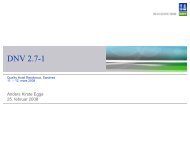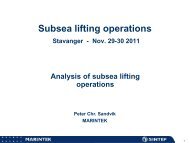NORSOK R-002 Rev. 2
NORSOK R-002 Rev. 2
NORSOK R-002 Rev. 2
Create successful ePaper yourself
Turn your PDF publications into a flip-book with our unique Google optimized e-Paper software.
Anskaffelse av Løfteinnretninger,<strong>NORSOK</strong> R-<strong>002</strong> Edition 2Lifting equipmentSvein Harald Hetland, MSc, BP Lifting Technical Authority
Standardize,SimplifySafer and more effectivePreliminary Edition 2, April 2010
<strong>NORSOK</strong> C-<strong>002</strong>Architectural components and equipmentEdition 3, June 2006• 20.10.1 General• Gantry cranes, monorails and lifting systems shall beprovided and arranged in close cooperation with theoperator/company.
Gyldighetsområde
<strong>NORSOK</strong> R-<strong>002</strong> Lifting Equipment:
Ny <strong>NORSOK</strong> R-<strong>002</strong> Lifting Equipment?• Behov for nytt regelverk innen:− Utsettingsarrangment− Løfteutstyr i boreområdet− <strong>NORSOK</strong> R-CR-<strong>002</strong> var fra 1995 og foreldetLære av hverandres feil for å unngå å gjøre dem selvProdusentene kan standardiseresikkert utstyr for petroleumsindustrienEn lettere hverdag for oss alleCraneaccidents
Standardisering av:Mengder med ulike krav og tilleggskrav hos de forskjellige oljeselskap• Eksempel: En forespørsel for ny offshorekran refererte til 70 forskjelige dokumenter og 3uker frist til å levere tilbudet• Vanskelig å forholde seg til for leverandører og produsenter (Take it or Leave it)?• Fordyrende og gir ingen forbedret sikkerhetseffekt.
Standardisering forenklerfor alle parter• En felles standard for alt løfteutstyr med relativt like krav for petroleumsindustri onshore ogoffshore.• Referanser til ISO, EN-, DNV standardere så langt som mulig• Samme sikkerhetskrav til flytende og faste installasjoner• Unngår for mange selskapspesifikketilleggskrav ved innkjøp• Gir krav til løfteutstyr for løfting avpersonell i petroleumsindustrien
R-<strong>002</strong> Content(Informative)Main partK: High risk applications1. Scope2. References3. Definitions4. General safetyrequirements5. CommonrequirementsH. Foundatiions andsuspensionsG. CranesF. Portable unitsJ. Lifting lugs and shacklesI. Elastic pennantsAnnexesE. LiftsD. Lifting equipment in drillingC. Lifting accessoriesB. Material handling principlesA. Launching and recoveryappliances for life savingequipment(Normative)9Classification: Internal 2012-02-20
Extract from introduction:The requirements of this <strong>NORSOK</strong> standard are given in clause 4, clause 5 and inthe annexes. The combination of all these requirements forms the technical basisthe lifting equipment has to comply with. In case of conflict between similar, but notidentical requirements, the requirements of the annexes prevail over the commonrequirements of clause 5, which in turn prevails over the safety requirements ofclause 4. However, this general rule may only be waived if the manufacturer makesuse of a recognised solution and documents by means of a risk assessment that saidsolution gives an equal or better safety level than the conflicting requirement.Technical basis:4 5 Annex“In case ofconflict betweensimilar, but notidenticalrequirements”:1st2nd3rdAnnex54Condition: Recognised solution10Classification: Internal 2012-02-20
Generell del – Kap. 44 General safety requirements (Design philosophy)− 4.1 Sikkerhet− 4.2 Egnethet for bruken (Fitness for Use)− 4.3 Pålitelighet og tilgjengelighet− 4.4 Prinsipper for integrering av sikkerhet− 4.5 Design med innebygget sikkerhet− 4.6 Vern, skjerming− 4.7 Information til bruker (Brukermanual)− 4.8 Styrke forhold (Sammenbruddsrekkefølge)− 4.9 Vedlikehold− 4.10 Kvalitetssikringssystem− 4.11 Risikoanalyse− 4.12 Risikoreduksjon− 4.14 Dokumentasjon av risikoanalyser− 4.15 Verifikasjon
<strong>NORSOK</strong> R-<strong>002</strong>, 4.1 Safety (1)• Lifting equipment shall be designed,fabricated, tested, installed andmaintained in such a way to reduceand minimise risks to humans, theenvironment and material assets.RiskHarmExtended harm= combination of probability of harm and severity of harm= physical injury or damage to health= damage to material assets or the environment13Classification: Internal 2012-02-20
<strong>NORSOK</strong> R-<strong>002</strong>, 4.1 Safety (2)• All forms of energy including lifting and movingobjects, represented or produced by liftingequipment, shall be controlled at any time in asafe manner.E p = mghE k = ½ mv 214Classification: Internal 2012-02-20
<strong>NORSOK</strong> R-<strong>002</strong>, 4.1 Safety (3)• The lifting equipment shall be designed such that nosingle technical failure results in an unacceptable risk.15Classification: Internal 2012-02-20
Hva er nytt?Maskinforskriftens sikkerhetsnivålegges til grunn også for:• Utsettingsarrangementer• Løfteutstyr i boreområdetRisikoanalyser, FMECA”Inherently safe design”,
Livbåt krok• Hvis krok er utenfor toleransene vil den åpne seg selv ved belasting og medførefritt fall (50-70 personer).Airgap between 0,3 mmand 0,6 mm
Inherently safe design measures− Design med innebygget sikkerhet• Pålitelige komponenter skal benyttes i designet,se ISO 12100-2.• Avhengig av risikoanalysen så skal:− “fail-safe” komponenter− Pålitelige komponenter (MTTF),− redundante komponenter brukes.
April 2004 Valhall Flanke Nord ulykken
Ledninger ble byttet om av elektrikeren:
4.12 Risk reductionProdusenten skal benytte alle muligheter for å redusere risikoen for skader på mennesker:Inkludert redesign,• Design modifikasjoner; Inherently safe by design.• Vern, skjerming og beskyttelseIterativ prosess• Informasjon til bruker; Brukermanualen.
4.2 Fitness for use (1)Design:• Simplicity• Comprehensibility• Maintainability• Recognisability22Classification: Internal 2012-02-20
4.2 Fitness for use (2)Selection:• Specific conditions at theworkplace• The work itself• Any risk that may ariseduring the work23Classification: Internal 2012-02-20
4.3 Reliability and availabilityLifting equipment shall be designed and constructed using well-provencomponents and safety principles to ensure reliability by withstanding• The operating stresses and loadings• The environmental influences• Other relevant influencesReliability = ability to perform andmaintain the required functionAvailability = ability to functionIn case of conflict:1. Safety2. Reliability3. Availability24Classification: Internal 2012-02-20
4.4 Principle of safety integration“Harm”:“Extended harm:”VibrationsElectricalhazards25Classification: Internal 2012-02-20
4.5 Inherently safe design measures• Fit for use• Reliable, well proven• Strength• Stability• Fail-safe• Redundant• Interlock• Ergonomic design• Etc.26Classification: Internal 2012-02-20
4.6 Safeguarding and complementaryprotective measures• Guards• Locking devices• Motion limiters, buffers• Rated capasity indictator• Rated capasity limiters• Overload protection devices• Alarms• Anti collision• Safe access and escape• Etc.27Classification: Internal 2012-02-20
4.7 Information for use• Text• Words• Signs• Pictograms• Signals• Symbols• Colors• Sounds, etc.28Classification: Internal 2012-02-20
4.8 Strength proportionThe strength elements (structural andmechanical) of lifting equipment shallbe designed such that theconsequences of accidentaloverloading or unexpected loadconditions which causes break downare known and minimised.This requirement does not apply forlifting accessories and portable units.For cranes this requirement may beachieved by ensuring that the firstelement to fail is not the foundation orany other element which is essentialfor the structural integrity of the entirecrane.29Classification: Internal 2012-02-20
4.9 Maintenance• Design for easy and efficientmaintenance• Access for maintenance• Maintenance priority:1. Safety2. Reliability3. AvailabilityAll lifting equipmentComplex lifting appliancesRisk assessment &Maintenance programReliability Centered Maintenance30Classification: Internal 2012-02-20
4.10 Quality management system• ISO 9001 or equivalent• Continuous improvement31Classification: Internal 2012-02-20
FromEN ISO 121004.11 Risk assessment32Classification: Internal 2012-02-20
Risks before riskreductionRisks after inherentlysafe designmeasuresRisks aftersafeguarding/protective measuresRisks afterinformationfor use4.12 Risk reductionShall comprise all possibilities to reduce the risk by using the 3 step method:1. Inherently safe design measures2. Safeguarding and possible complementary protective measures3. Information for use1.2.3.Residual risks to behandled by the user33Classification: Internal 2012-02-20
Internal verificationNotified body, if applicableEnterprice of competence4.13 Documentation of risk assessment / 4.14 VerificationTechnicalconstruction file(5.25)Riskassessmentreport3 rd partyverification,DNVOSS-308or eq.Use4.15 Qualification of new technology ?34Classification: Internal 2012-02-20
5 Common requirements5.1 Suitability5.2 Materials and products35Classification: Internal 2012-02-20
5.3 Fire and explosionSome standardsreferred to:• EN 13463• <strong>NORSOK</strong> S-001• EN 13478• ISO 7010• IEC 60079 series• EN 1127-1• IEC 61892• <strong>NORSOK</strong> S-<strong>002</strong>• ISO 13702“All types of lifting appliances, fixed, mobile or temporary,electrical or non-electrical, installed or used in hazardousareas, shall comply with ATEX requirements, i.e. Zone 0,Zone 1 or Zone 2”.“Electrotechnical equipment mounted externally(exposed to potential explosive atmosphere) on liftingappliances located in non-hazardous areas, shall as aminimum be classified for use in hazardous area Zone 2,see <strong>NORSOK</strong> S-<strong>002</strong>. Crane boom movements mayrequire Zone 1 equipment”.“Lifting appliances which represent a hazard if operatedin an explosive atmosphere, shall be equipped with anautomatic shut-down system which is activated uponconfirmed gas detection in the crane ventilation systemor in the combustion air inlet, without delay, see<strong>NORSOK</strong> S-001”.36Classification: Internal 2012-02-20
5.4 ErgonomicsTopics covered:• Operator position• Escape and access• Marking• Illumination• Unexpected start-up• Guards• Crushing hazard• Falling objects• Mechanical vibration and shock• Handling and transport facilities• Hot surfaces37Classification: Internal 2012-02-20
5.5 Environmental conditions and 5.6 Operational loadsOperational parameters such as:• Temperatures• Atmosphere• Radiation• Wind• Waves• Sea induced motions and inclinations• Operational loadsthat need to be communicated in time betweenthe manufacturer, the supplier and the end user38Classification: Internal 2012-02-20
5.7 Strength and stability – structureThe strength and stability design of liftingequipment shall be made in accordance withrecognised international standards anddesign codes.The following standards should be used:• NS-EN 13001-1• NS-EN 13001-2The following technical specifications shouldbe used:• CEN/TS 13001-3-1• CEN/TS 13001-3-2• prCEN/TS 13001-3-3• prCEN/TS 13001-3-4For fatigue design of steel structuresreference is made to DNV RP-C203.39Classification: Internal 2012-02-20
5.15 Emergency systemsEmergency lowering system required for power operated liftingappliances for suspended loads• Positioned to give a clear view to the load• “hold to run” function• Controlled lowering• Simple to operate• Available without undue delay (15min to land the load)• Clear and unambigous operation procedureEmergency operation system (EOS) required for lifting appliances for thelifting of persons• Move the load in any direction• Secondary independent power supply system• Secondary independent control system• Simple to operate, one motion at the time• 10% speed• Separate emergency stop46Classification: Internal 2012-02-20
5.16 Communication• Cranes and enclosed control stations: Permanentlyinstalled telephone system• Lifting appliance with enclosed control stations:Permanently installed UHF/VHF radio facilities with“handsfree” send/receive function• Lifting appliances with an enclosed control station shall befitted with an external loadspeaker/alarm horn that can beoperated “handsfree”.47Classification: Internal 2012-02-20
5.17 Pneumatics & 5.18 HydraulicsPneumatics:EN ISO 4414Hydraulics:EN ISO 4413• The hydraulic system should be fitted with metallic tube connections for fluid power withelastomeric sealing rings in accordance with ISO 8434 or DIN 2353 combined with hydraulicpipes with cold formed tube ends.• Flexible hoses shall not be used between any load holding valves and hydraulic motors orcylinders.• <strong>NORSOK</strong> standard specifications for piping and pipe fittings for process plants and instrumenttubing shall not be used for lifting appliances.48Classification: Internal 2012-02-20
5.21 Utility systemsSightLifting appliances which have an enclosed control station shall have permanentmeans for window cleaning operated from inside the control station. In additionaccess means shall be provided for replacement of windshield wipers and manualcleaning of the windows from the outside.VentilationIndoor climate of lifting appliances shall be in accordance with <strong>NORSOK</strong> S-<strong>002</strong>, 5.7.Utility suppliesLifting appliances shall have permanent arrangements for utility supplies (e.g. water,fuel, service air and electrical connections), as applicable. Details to be agreed upon.Lifting appliances containing fuel, oil, grease etc. which represent a hazard to theenvironment, shall have permanent arrangements for enclosed drainage to tank.50Classification: Internal 2012-02-20
5.22 Fabrication 5.23 Installation and assemblyLifting appliances shall be fabricated,installed and assembled in accordance withDNV Standard for certification of liftingappliances No. 2.22, Ch.2, Section 2Materials and fabrication. This include e.g.• material selection,• material certificates,• material quality,• welding,• forming (hot or cold),• inspection and testing.For installation and assembly relevant partsof <strong>NORSOK</strong> Z-007 also applies.51Classification: Internal 2012-02-20
5.24 Corrosion protection, Surface preparation,Protective coating and Bolting• Due consideration to risk of corrosion when selecting materials and materialcombinations• Surface preparation and protective coating shall be in accordance with <strong>NORSOK</strong>M-501 and/or ISO 12944-1.• Corrosion resistant steel shall be used for external bolting of 10 mm diameter andsmaller. (NB: For temperaturer >50 grader bør en ikke bruke vanlig 316 eller 316Lpga. Chloride cracking)• Larger bolts shall normally be hot-dip galvanised low alloy steel. If other qualitiesare used, special corrosion protection measures shall be applied, e.g. protectedcups grease filled.• Bolt assemblies that are essential to mechanical safety, shall be in accordance withISO 898-1 and DNV Standard for certification of lifting appliances, No.2.22, Ch.2,Sec. 2, C200 and D400.52Classification: Internal 2012-02-20
5.25 Technical construction file• A technical construction file shall be compiled by the manufacturer of liftingequipment.• The technical construction file shall address all requirements of this <strong>NORSOK</strong>standard, as applicable.• The technical construction file shall be prepared and presented in such detail that athird party is able to perform a verification of the product according to therequirements of this <strong>NORSOK</strong> standard, without supplementary information.53Classification: Internal 2012-02-20
5.25 Technical construction file, continuedThe technical file shall contain, as a minimum,• unique identification details of the lifting equipment,• design specification including design parameters,• risk assessments including resulting risk reduction measures and residual risk level,• applicable requirements for the lifting appliance,• standards and codes used,• technical information, such as drawings, diagrams, calculations, test reports etc.,• fabrication documentation, e.g. material certificates, fabrication procedures, weldingdocumentation etc.,• verification reports,• formal statements, declarations and certificates,• instructions for use, including inspection and maintenance instructions, including wear andtear tolerances, non destructive examination (NDE) programmes, if applicable.54Classification: Internal 2012-02-20
5.25. Instruction for use• The instruction for use shall be made available to the enduser.• The instruction for use of lifting appliances shall be inaccordance with EN 12644-1.• The instruction for use of lifting accessories shall be inaccordance with EN 13155, 7.1.• The maintenance instructions shall include amaintenance programme in accordance with 4.9.• The maintenance instructions shall include information ontraining of operators and maintenance personnel.• In the case of complex lifting appliances, the informationon training of operators and maintenance personnel shalltake into account the local conditions on/at the installationand its location.55Classification: Internal 2012-02-20
Lifting appliances withinherently safe design.
•PAUSE 10 minutter
Annex G (Normative) Cranes58
Annex G – Cranes - Requirement philosophyAdditional requirements due to the“offshore risks”<strong>NORSOK</strong> R-<strong>002</strong>EN Standards for cranesHigh risk application?Annex K59
WG11Mobile cranesWG12Tower cranesWG13Slewing jib cranesWG14Bridge and gantryWG15Offshore cranesWG16Floating cranesWG17Winches and hoistsWG18Loader cranesWG19Cable cranesWG20Hand operated cranesWG21Non fixed attachmentsWG22Manipulating devicesCEN/TC147 Crane safetyTC147WG1 Terminology and harmonisationWG2 Crane Safety – Design - GeneralWG3 Crane Safety – Design – Requirements for equipmentWG4 Crane Safety – Requirements for health and safetyWG5 Crane Safety – Requirements for inspection and safe use6004February2013
Annex G Cranes –types61
<strong>NORSOK</strong> R-CR-<strong>002</strong> Lifting Equipment 1995Data sheet specification
G.3 Design criteriaStrength proportion, ref. 4.8Design loads, ref. 5.7Principle for proof of competence:EN13001-1Load combinations: DNV SC 2.22Loads, load actions, load combinations and load effects: EN13001-2Fatigue:DNV RP-C203Mechanisms: FEM 1.001EN13135-2Operating temperaturesT 0min = -20°C unless otherwise agreed63
G.3 Wind loadsCranes located outdoor in exposed areasshall be designed for loads due to wind inaccordance with EN 13001-2. The windvelocities shall unless otherwise agreedbetween the buyer and the manufacturer,be taken as follows:a) 25 m/s for in service;b) 63 m/s for out of service.NOTE These wind velocities are to beunderstood as a 3 s gust wind. Windvelocities are often given as 10 min meanwind velocity. A 3 s gust wind velocity of 25m/s will correspond to about 17 m/s 10 minmean wind velocity, but may depend onsurrounding structures on the platform.66
G.3.7 Lifting of personsFor the lifting of persons, the methods of decreasing the probability of failure inaccordance with EN 13135-2, 5.12.3.2, shall be applied.The risk coefficient g n for cranes designed for the lifting of persons, shall beminimum 1,5.The required performance level for cranes lifting personnel shall be d inaccordance with ISO 13849-1.See also item 5.9 and annex K High risk applicationsG.3.8 Cranes for temporary use offshorePowered cranes intended for temporary use on an offshore installation shallalso comply with <strong>NORSOK</strong> Z-015.67
G.4 Cranes with emergency operation system (EOS)• Initiated and controlled from the control station• Secondary independent power supply• Secondary independent controls• Main functions for moving the load – one at the time• Simple to operate without undue delay (1 min)• Min.10% of required speeds• Emergency stop68
Mobile cranes (Group G1)Use:EN13000:2010 + G.1 + General part of<strong>NORSOK</strong> R-<strong>002</strong>(Additional requirements if used for the lifting ofpersons and high risk applications)69
Tower cranes (Group G2)(Tårn kran)Use:EN14439:2006+A2:2009 + G.1 + Generalpart of <strong>NORSOK</strong> R-<strong>002</strong>(Additional requirements if used for the lifting ofpersons and high risk applications)70
Slewing Jib cranes(Portalkran) (Group G3)(Slewing hydraulic deck crane.)Use:EN14985:2012 + G.1 + General part of<strong>NORSOK</strong> R-<strong>002</strong>(Additional requirements if used for the lifting ofpersons and high risk applications)71
Bridge and gantry cranes(Group G4)Use:EN15011:2012 + G.1 + General part of<strong>NORSOK</strong> R-<strong>002</strong>(Additional requirements if used for the lifting ofpersons and high risk applications)72
Offshore cranes (Group G5)Use:EN13852-1 + G.1-G.6 + Generalpart of <strong>NORSOK</strong>R-<strong>002</strong>Size, capasity, no. off, location etc:•Compatible with Annex B (Material handling and offshore crane study)•Capable of offboard lifting in Hs=6m at 25m outreach•Capable of offboard lifting of 15 tonnes at Hs=0 at 32m from the side of theinstallation.•Reflect the need of redundancy and ensure optimal working conditions•Unobstructed sight and avoid blind zones73
Offshore cranes (Group G5), continuedHook velocities:ViKiV2DV2CV HV RV LWith and without loads80
Single fall, hook No hook loadload, factor 0,78FACTOR 0,78 Hook load 16 000Required speedNet powerSWH Fixed Semi FPSO Fixed Semi FPSOm1,00 0,64 0,67 0,75 102 106 1191,50 0,89 0,93 1,06 142 149 1702,00 1,10 1,17 1,35 176 187 2162,50 1,29 1,38 1,62 207 221 2593,00 1,46 1,57 1,87 233 252 2993,50 1,61 1,75 2,11 257 279 3374,00 1,74 1,91 2,34 279 305 3744,50 1,86 2,06 2,56 298 329 4095,00 1,97 2,20 2,77 315 351 4435,50 2,07 2,33 2,98 331 373 4776,00 2,16 2,45 3,18 345 393 509Multiple fall, hook load 0,74FACTOR 0,28 Hook load 32 000Required speedNet powerSWH Fixed Semi FPSO Fixed Semi FPSOm1,00 0,23 0,24 0,27 99 104 1171,50 0,32 0,33 0,38 138 146 1662,00 0,40 0,42 0,48 172 183 2112,50 0,46 0,50 0,58 202 216 2533,00 0,52 0,56 0,67 228 246 2923,50 0,58 0,63 0,76 251 273 3294,00 0,62 0,68 0,84 272 298 3654,50 0,67 0,74 0,92 291 321 4005,00 0,71 0,79 0,99 308 343 4335,50 0,74 0,84 1,07 323 364 4656,00 0,77 0,88 1,14 337 383 497
Single fall, hook loadFACTOR 0,50 Hook load 16 000Required speedNet powerSWH Fixed Semi FPSO Fixed Semi FPSOm1,00 0,41 0,43 0,48 65 68 771,50 0,57 0,60 0,68 91 96 1092,00 0,71 0,75 0,87 113 120 1392,50 0,83 0,89 1,04 133 142 1663,00 0,94 1,01 1,20 150 161 1923,50 1,03 1,12 1,35 165 179 2164,00 1,12 1,22 1,50 179 196 2404,50 1,19 1,32 1,64 191 211 2625,00 1,26 1,41 1,78 202 225 2845,50 1,33 1,49 1,91 212 239 3066,00 1,38 1,57 2,04 221 252 326EN 13852-1:2013 Horizontal luffing speed for Heavy duty operation:Luffing with loadFACTOR 0,25 Hook loadRequired speedSWH Fixed Semi FPSOm1,00 0,17 0,18 0,211,50 0,24 0,25 0,302,00 0,30 0,33 0,392,50 0,36 0,39 0,473,00 0,41 0,45 0,553,50 0,46 0,51 0,634,00 0,50 0,56 0,714,50 0,54 0,61 0,785,00 0,58 0,66 0,855,50 0,61 0,70 0,926,00 0,64 0,74 0,99Luffing with loadFACTOR 0,20 Hook loadRequired speedSWH Fixed Semi FPSOm1,00 0,13 0,14 0,171,50 0,19 0,20 0,242,00 0,24 0,26 0,312,50 0,29 0,31 0,383,00 0,33 0,36 0,443,50 0,37 0,40 0,514,00 0,40 0,45 0,574,50 0,43 0,49 0,625,00 0,46 0,52 0,685,50 0,49 0,56 0,746,00 0,51 0,60 0,79<strong>NORSOK</strong> harkrav om 0.2faktor forbomforflytting ihorisontal planet[m/s]
5.2 Load: at radius: m T m T m5.3 Max. radius: m5.4 Min. radius m5.5 Lifting height above slewing ring m At radius:5.6 Lifting height below slewing ring m At radius:5.7 Hoist speed: with load as in 5.1 m/s m/s5.8 Hoist speed: with load as in 5.2 m/s m/s5.9 Hoist speed without load: m/s m/s5.10 Hoist speed cont. variable betweenzero and max:5.11 Hoist speed variable with load:Hoist 2 (WHIP) if required5.12 Max. load: T5.13 Max. radius: m5.14 Min. radius: m5.15 Lifting height above slewing ring m At radius:5.16 Lifting height below slewing ring m At radius:5.17 Hoist speed: with: T m/s5.18 Hoist speed: with: T m/s5.19 Hoist speed without load: m/s5.20 Hoist speed cont. variable between zero and max:5.21 Hoist speed variable with load (const. torque motor):6 DATA FOR SLEWING AND LUFFING6.1 Slewing speed with max. load in hook:6.2 Slewing operation with full load at max.:6.3 Luffing time with max. load: from: ° boom angle to: ° boom angle time:
Store hastigheter og store kraner =Dynamiske tilleggskrefter=Rykk og napp pga. lite dempning ved belastning med stor hastighetFiskestangsom ertilpassetfisken,demperrykk ognappFor svakfiskestangeller for storlast kanvære sværtuheldigSterk og stiv kran kangi store dynamisketilleggskrefter. Spesieltrisiko for brudd påløfteørene ogriggearrangementet påliten last.
Høyere DAF ved 50% utnyttelse av SWLwireDAF=2.6
Dynamisk last i wire med SWL 16t whip line og 100% utnyttet (16 t last)DAF=1.5
Høyere hastighet ved plutselig belastning, gir størrerykk (Dynamiske tilleggskrefter)Figuren visermange kilder til atden relativeløftehastighetenkan bli stor.Stor hastighet kanmedføre stort rykk.Spesielt ved slakkwire, som plutseligblir belastet medlast I stor hastighet,gir høy DAF.
Dynamisk faktorLegg merke tilat liten lastunderbrøkstreken girstort bidrag tilDAF.
DAF forenklet formel:• Forenklet regne eksempel:− Benytter 50t kran for løft på henholdsvis 50t og 1t:• Antar lik løftehastighet for begge løft (1 m/s):− DAF 50t =1+1√50t/50t =(1+1*1)= 2− DAF 1t =1+1√50t/1t =(1+1*7)= 8
DAF forenklet formel:• Forenklet regne eksempel:− Benytter 50t kran for løft på henholdsvis 50t og 1t:• Antar ulik løftehastighet (0,5 m/s) og (2 m/s)− DAF 50t =1+0.5√50t/50t =(1+0,5)= 1,5− DAF 1t =1+2√50t/1t =(1+2*7)= 15
<strong>NORSOK</strong> R-<strong>002</strong> Annex FDAF =Dynamisk faktor for løft off board/in board
MOB-båt løfting
Cranes for subsea operation(Group G5, G6, G7 etc.)Additional requirements to address:•Sea water penetration and corrosion•Load hoist drum•Rated capacity indicator•Rope tensioning system•Heave compensation system•Performance level•Subsea operation mode•AOPS•Instruction for use94
Aktiv hiv kompensering reduserer dynamisketilleggskrefter
Levetid blirredusert i løpet avfå minutter vedhøy belastningHøytemperaturPga. AktivHivKomp.
NYTT KRAV I<strong>NORSOK</strong> R-<strong>002</strong>
Power driven winches andhoists (Group G7)Winches:EN14492-1 + G.1-G.6 + General part of <strong>NORSOK</strong> R-<strong>002</strong>Hoists:EN14492-2 + G.1-G.6 + General part of <strong>NORSOK</strong> R-<strong>002</strong>(Additional requirements if used for the lifting ofpersons, subsea lifting and high risk applications)99
Loader cranes (Group G8)Use:EN12999 + G.3 + General part of <strong>NORSOK</strong> R-<strong>002</strong>(Additional requirements if used for the lifting ofpersons and high risk applications)100
Hand powered hoists andtrolleys (Group G10)Use:EN13157 + G.3 + General part of <strong>NORSOK</strong> R-<strong>002</strong>Double set of braking pals and overload protection system(Additional requirements if used for high riskapplications)101
Other cranes (G20)The design criteria stated in G.3 apply.•Mobile elevating work platforms shall be inaccordance with EN 280.•Mast climbing platforms shall be in accordance withEN 1495.•Suspended access equipment shall be in accordancewith EN 1808.•Lifting tables shall be in accordance with EN 1570.For cranes used in drilling operations, reference is alsomade to the requirements in Annex D.NOTE Powered slewing cranes mounted in a fixed installation(often referred to as “G20 cranes” in the industry) are coveredby Group G3.102
Annex K High risk appliances (Informative)103
Why high risk applications?104
Why high risk applications?Lifeboat launching arrangement incidentDuring testing, a 85mm Ø solid piston rod of a hydraulic cylinder failed,lifeboat with crew of 5 saved to fall to sea by second cylinder.106
107Luffing winch gear Statoil GFA Offshore crane
Boom failure during lifting of persons
What are high risk applications?Hamonised standards adress technical solutions for the vast majority of cranes. Cranes are sometimes used inapplications which represent exeptional risks.The exeptional risks can be assosiated with major accidents, where the crane or the lifting operation might causeseroius harm beyond the damage of the crane or the load itself.Such unacceptable consequences need to be avoided regardless of the probability.111
High risk applications - typicalSome cranes have higher risk than others:− Lifting of or over persons− Lifting in nuclear plants− Lifting of explosives and radioactive materials− Lifting of hot molten metal− Operations in explosive atmospheres− Lifting over explosives, flammable and dangerous chemicals− Lifting of giant constructions112
SPØRSMÅL?
ConsequenceRisk matrixHigh riskapplicationsNormalapplicationsProbabilityThe potential consequences of high risk applicationsneed to be avoided/reduced regardless of the probability114
Strategy for mitigation of high risksOperationalmeasures (M)Technologicalmeasures (T)Organisationalmeasures (O)ProbabilityreductionCompetence,training andprocedures,etc.Fail-safe, redundantand improvedtechnical solutionscombined withmonitoring, etc.Resources andcapabilities, etc.ConsequencereductionEmergencypreparednessplans,etc.Strengthproportion,emergencysystems,instructions foruse, etc.Strategies formajor accidents115
K.2 Principle of high risk reductionThe prioritized sequence of reducing high risks:1. Inherent safe design, see K.32. Protective measures, see K.43. Information for use, see K.5116
K.3 Inherent safe design• Inherent safe design shall ensure that a component or element which are neededto suspend or move the load or main parts e.g. the boom, of the lifting appliance,does not cause the load or the part of the lifting appliance to fall or moveunexpectedly in case of a single failure.• All load bearing structure, mechanisms and suspensions for high risk applicationsshall either be redundant (duplicated) or be designed with an increased riskcoefficient, γn .• Redundancy by duplicating components shall be the preferred measure, except forstructure such as foundations, pedestals, superstructure, booms and mechanismswhere duplication is normally not feasible or will create other significant hazards ofhigh risks.
Table K.2 Examples of duplication related to high risk classExample of duplication High risk class I High risk class IIBackup brake with independent load path on singlewinchSingle hydraulic cylinders with mechanical lockSingle winch with dual load suspension system(wireropes or chains)XXXDual winch with dual suspension (Single failure proof) X XDual hydraulic cylinders with independent load holdingvalves (Single failure proof)XX
Table K.3 Risk coefficient for high risk classesγnHigh risk class I Min. 1,5High risk class II 2γn is the risk coefissient as defined in EN13001-2.
Table K.4 Required performance level (EN ISO 13849-1)Performance level PLrHigh risk class IHigh risk class IId or eePLr = d, Average probability of dangerous failure per hour >= 10 -7 to < 10 -6PLr = e, Average probability of dangerous failure per hour >= 10 -8 to < 10 -7
Other protective measures and information for use• Back-up motion limiters of diverted technology• Crane level limiter for mobile cranes, loader cranes etc.• Automatic rigging detection system• Emergency operation system (EOS)• Competence• Operation, inspection and maitenance• Specific operational risk analysis• Planning of lifting routes• Operational limitations• Protection of equipment• Lifting accessories
High Risk Application summarySafety related partsof control system:Performance levelPLr = d or e(single failure proofwith monitoring)acc. to ISO 13849-1Instruction foruse and userrequirements:AdditionalrequirementsInstallation structureCranefoundationMainstructureBoomLoadStructure and mechanisms:Increased capacity due to strengthproportion and a risk coeficcientIncreased capacity due to a riskcoefficientRedundancy by dual components andload equalizationIncreased capacity due to a riskcoefficientRedundancy by dual components andload equalizationDual suspension points122


